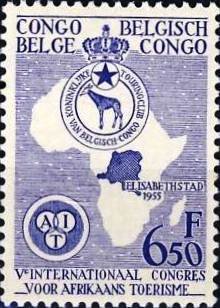Stamp: Map of Africa & Emblem of Royal Touring inscribed in Flemish (Belgian Congo 1955)
Map of Africa & Emblem of Royal Touring inscribed in Flemish (Belgian Congo 1955)
26 July (Belgian Congo ) within release 5th international congress of African tourism goes into circulation Stamp Map of Africa & Emblem of Royal Touring inscribed in Flemish face value 6.50 Belgian franc
| Stamp Map of Africa & Emblem of Royal Touring inscribed in Flemish in catalogues | |
|---|---|
| Michel: | Mi:BE-CD 331 |
| Stamp Number: | Sn:BE-CD 299 |
| Yvert et Tellier: | Yt:BE-CD 338 |
| Belgium: | Bel:BE-CD 338 |
Stamp is vertical format.
The International Congress of African Tourism was held in Elisabethville on 26 July – 4 August 1955. The design of the stamp depicts a map of Africa with the emblem of the Touring Club of Congo with an Okapi in the middle. On top of the emblem a crown is placed, to indicate the Royal status. Text in dutch.Also in the issue 5th international congress of African tourism:
- Stamp - Map of Africa & Emblem of Royal Touring inscribed in French face value 6.50;
- Stamp - Map of Africa & Emblem of Royal Touring inscribed in Flemish face value 6.50;
Stamp Map of Africa & Emblem of Royal Touring inscribed in Flemish it reflects the thematic directions:
A map is a symbolic depiction emphasizing relationships between elements of some space, such as objects, regions, or themes. Many maps are static, fixed to paper or some other durable medium, while others are dynamic or interactive. Although most commonly used to depict geography, maps may represent any space, real or imagined, without regard to context or scale, such as in brain mapping, DNA mapping, or computer network topology mapping. The space being mapped may be two dimensional, such as the surface of the earth, three dimensional, such as the interior of the earth, or even more abstract spaces of any dimension, such as arise in modeling phenomena having many independent variables. Although the earliest maps known are of the heavens, geographic maps of territory have a very long tradition and exist from ancient times. The word "map" comes from the medieval Latin Mappa mundi, wherein mappa meant napkin or cloth and mundi the world. Thus, "map" became the shortened term referring to a two-dimensional representation of the surface of the world.

